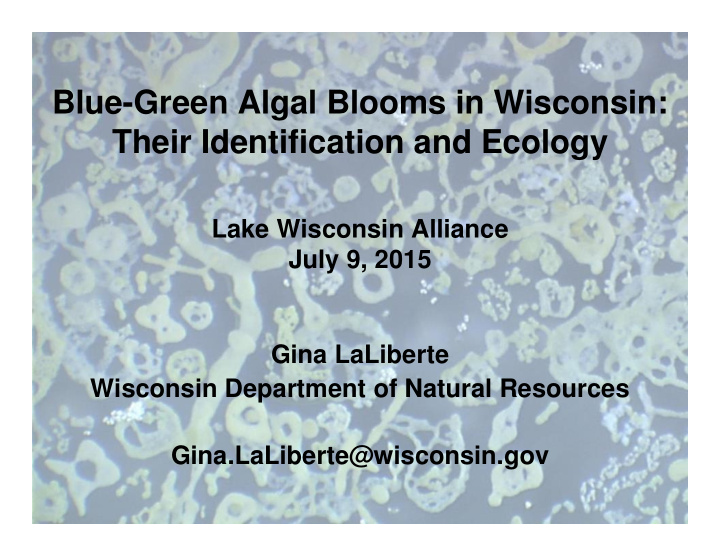



Blue-Green Algal Blooms in Wisconsin: Their Identification and Ecology Lake Wisconsin Alliance July 9, 2015 Gina LaLiberte Wisconsin Department of Natural Resources Gina.LaLiberte@wisconsin.gov
What are they & what do they look like? When, where, and why do they bloom? Are they toxic? Can I even go in the water? Okee Bay on Lake Wisconsin, Columbia County – S. Graham
Blue-green algae are different from true algae • Photosynthetic bacteria (cyanobacteria) • Native to every lake & river in Wisconsin • Buoyancy: they regulate depth in water • Temperatures: they like it hot • Toxins: produced by some species. Not all blue-green algae make toxins, and toxins are not made all the time.
“Blue-green” is misleading J. Williamson N. Trombly Intact blooms are most often green in color. S. Greb E. Heath
intact decomposing pigments are released M. Meade Spirogyra J. Williamson B. Butterfield
N. Trombly R. McLennan J. Williamson T. Moris R. McLennan WDHS J. Williamson A. Dryja
Can be mistaken for duckweeds Duckweeds ( Lemna , Lemna , Spirodela , Wolffia Spirodela ) have roots Watermeal ( Wolffia ) is tiny, firm, and grainy in texture. Wolffia are oval or doubled ovals in shape. Watermeal ( Wolffia )
Can be mistaken for pollen Look for similar yellow “dust” on land
Can be mistaken for filamentous green algae Filamentous green algae are long and hair-like.
Planktonic blue-green algae Aphanizomenon Gloeotrichia Anabaena Cylindrospermopsis Microcystis
Floating Blue-green Algal Mats Oscillatoria mats E. Evensen
What causes harmful blooms? • Excess nutrients are fertilizer for growth of plants and algae • Primarily P, but N is important too • Warm water and calm weather M. Meade WDNR
The details are more complicated… • Species and strains • Cell biochemistry • Micronutrients (iron) • Dissolved carbon • Zebra & quagga mussels; carp • Nutrients & cells from lake sediments “ Favorable environmental conditions” – Mark Vander Borgh, NCDENR
What lakes have blue-green algae? Where are blooms most likely to occur? Blooms likeliest in: • Lakes with large watersheds • Shallow lakes • Impoundments They are in ALL lakes!
Management & Monitoring Challenges • Grow better in high water temperatures • Store phosphorus for later use • Nitrogen fixation in some species • Blooms are dynamic in space & time Lake Monona, Dane County. June 2, 2015. Sites 4.5 km (2.8 miles) apart.
World Health Organization Guidelines Probability of Cell Density Microcystin-LR Chlorophyll Adverse Health (cells/ml) (ug/L) (ug/L) Effects Low < 20,000 < 10 < 10 Moderate 20,000-100,000 10 – 20 10 – 50 High 100,000- 20 – 2,000 50 – 5,000 10,000,000 Very High > 10,000,000 > 2,000 > 5,000 Graham et al. 2009, based on World Health Organization’s 2003 Guidelines for Safe Recreational Water Environments
31,000 cells/ml 255,000 cells/ml N. Trombly S. Graham 3,000,000 cells/ml 51,000,000 cells/ml K. Schreiber C. Fitzgibbon
Are they toxic? Can I even go in the water? Look for advisory signs Posted by public health officials Lack of posted advisory does not mean that algal blooms will not occur in that lake! BBE Moldaenke Can’t we test more? Blooms change rapidly Results can be slow Expensive! BBE Moldaenke http://bit.ly/1bF5YwK J. Williamson (Does not imply endorsement by WDNR or WDHS)
Are they toxic? Can I even go in the water? How does the water look? Can you see your feet in knee-deep water? Milkshake, pea soup, or paint? � T. Bridgeman, University of Toledo Do you have a lot of allergic sensitivities? Skin exposure might affect you. WDNR
Are they toxic? Can I even go in the water? Does the water smell? Geosmin, 2-methylisoborneol (MIB) – earthy, musty odors Graham et al. 2010: geosmin & MIB co-occurred with toxins http://bit.ly/1dPjZGC Cyanotoxins can still be present without odors Burpee.com Try to avoid swallowing water, no matter how clean it looks (especially after a rainstorm!) Giardia CDC DPDx E. coli , Giardia , Cryptosporidium , Shigella , Norovirus, other pathogens…
How to be safe? • Can you see your feet in knee-deep water? If not, avoid ingesting any water; keep kids & pets out! • Avoid swimming in and boating through blue- K. Schreiber, WDNR green algal scums and “pea soup” water. • Always shower after swimming in a lake, river, or pond. • Keep pets out of scummy water, and wash them off immediately if they swim When in doubt, or wade in water with keep out! lots of algae.
dnr.wi.gov and dhs.wisconsin.gov Search for “algae”
Recommend
More recommend